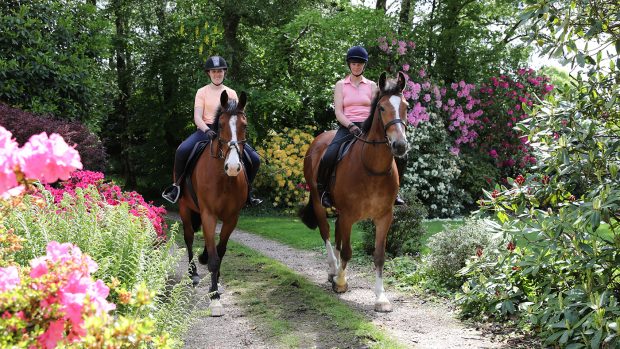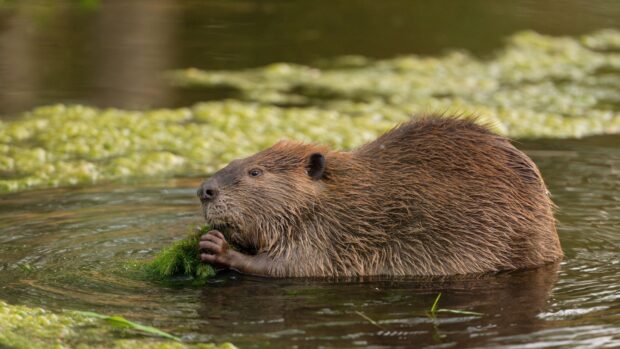Have you ever wondered how to stop your horse being pushy on the ground? Does he barge when you lead him or refuse to stand tied up?
Dr Gemma Pearson, a qualified equine veterinary behaviourist who is director of equine behaviour for The Horse Trust, says improving this sort of problem comes back to training the horse’s basic responses.
“A lot of people will say, ‘I walk and my horse walks and I stop and my horse stops’ but this can lead us into problems,” she says, explaining that the horse’s cue to walk or stop in that situation is the person’s legs moving.
“So then you tie the horse up and walk away. Your legs have moved, but now you don’t want to horse to follow you, so that can be a bit confusing for the horse. Or the horse follows you until you go up the ramp of the trailer and then the horse doesn’t follow you any more, so what’s the next thing people do? They put pressure on the lead rope.
“In the case of the horse stopping when you stop, if a wheelie bin falls over behind your horse and it jumps forward, you’ll probably be knocked to the side anyway, but the next thing you do is put pressure on that lead rope [which the horse doesn’t understand as a cue] and that horse is not looking at your body language. So it’s really useful to teach horses to go and stop from pressure from the lead rope.”
How to stop your horse being pushy: retraining the basis responses
Gemma starts with the horse in halt and without moving her feet, puts gentle forwards pressure on the lead rope.
She says: “As soon as the horse goes to step forwards, I release that pressure back to neutral. Then of course you have to start walking with the horse, but the key thing is that the horse’s cue to move forward is pressure from the lead rope.
“The easiest thing with teaching a horse to stop is to teach it back up because the same muscles are involved in backing up as stopping. Stand still, facing the horse, so you can watch what the hooves are doing. Put light pressure on the lead rope and as soon as a hoof lifts off the ground and starts to go backwards, release the pressure.
“The timing is so crucial to training the correct response here because the horse then starts to think, ‘Oh the way to make pressure go away when the pressure is backward is to step back, the way to make pressure go away when the pressure is forwards is to step forwards.’ And once the horse understands that, you can lead them forwards, you put backwards pressure on the lead rope and the horse will stop.”
Gemma says that once these responses are ingrained, in the scenario where a wheelie bin falls over and the horse shoots forward, they get to the end of the lead rope, feel pressure and stop.
She also gives an example of a situation where a young horse being trained to lead was useful. Her partner at the time was a farmer and rang her at work, at a vet hospital, to say her three-year-old stallion had cut its leg and needed vet attention. She told him to put the horse in the trailer and bring him in to work.
“He said, ‘But he’s never been in a trailer before’ and I said, ‘No, but I’ve taught him to lead correctly.’ So he arrived there and I asked how he was loading, and he said, ‘Yeah, I walked him up to the ramp and he went to stop and I put pressure on the lead rope and he stepped forward and then he was in the trailer.’ Obviously that’s not ideal – we want to practise before we take horses on journeys – but in this scenario, we had to get him up to my work.”
Pushy horses: they’re not naughty
Gemma says people often think bargy or pushy horses don’t respect humans, are naughty or think they’re the boss.
“None of that is true, it’s simply because we haven’t taught them to lead correctly,” she says. “So if you have a bargy horse just teach them to go forwards, to stop, to step back, and when you’re leading them, if they start to accelerate a little bit, just slow them down again.
“You’ll know if this works because horses shouldn’t change their head and neck position when you give them a lead rope cue. With bargy horses, what happens is they start to go faster than the person wants, often into the person, the person puts pressure on the lead rope and they raise their head in the air or they flex their head and neck or they bend their head and neck round to the side and that is their response to lead rope pressure. So just by teaching them to immediately slow off light pressure, these horses stop being bargy.”
Teaching horses to stand still
Gemma reiterates that in terms of teaching horses to stand still unless they are given a cue otherwise, it’s important not to teach the horse to follow your legs, as otherwise if the horse is tied up or in the trailer and you move away, it is receiving confusing signals.
To teach her horses to stand still she faces the horse, looks at it and at their hooves particularly.
She says: “Then I might take half a step back and if the horse tries to follow me, I’ll step them back to where they started and give them a scratch. Then I might take half a step and if they don’t follow me, I’ll go in and give them a scratch. I’ll build that up until I can walk all the way to the end of the lead rope and the horse doesn’t follow me.
“I may then put the lead rope over the end of the neck – if I’m in a safe enclosed space – and walk all the way round the horse and the horse doesn’t follow me. So they learn to stand still unless they’re asked to do otherwise.”
If you’re thinking about how to stop your horse being pushy, this is advantageous.
“A horse that stand still as a habit is calm as a habit, she says. “When we talk about bargy horses, they have a high level of arousal. Whether it’s excitement or stress, their level of arousal is too high and that’s why they start pushing into people.
“So teach them to stand still as a habit, to be calm as a habit, to step forwards and back off lead rope pressure. This means they are really light and then they develop their own self carriage [continuing at the same speed until cued otherwise] for leading correctly.”
You might also be interested in:

The Horse & Hound Podcast 131: International dressage rider Abi Lyle | Teaching horses to stand still | News round-up

5 headcollars for strong horses

Why a pat on the neck isn’t what your horse would choose and how to use rewards effectively in training

7 rope halters that give more precise aids for training

How to retrain a horse who bucks or rears – and why hitting them is never the answer

Horse & Hound’s beginners’ guide to clicker training

How to retrain a strong horse so you can slow down and stop in a snaffle

Subscribe to Horse & Hound magazine today – and enjoy unlimited website access all year round
Horse & Hound magazine, out every Thursday, is packed with all the latest news and reports, as well as interviews, specials, nostalgia, vet and training advice. Find how you can enjoy the magazine delivered to your door every week, plus options to upgrade your subscription to access our online service that brings you breaking news and reports as well as other benefits.




